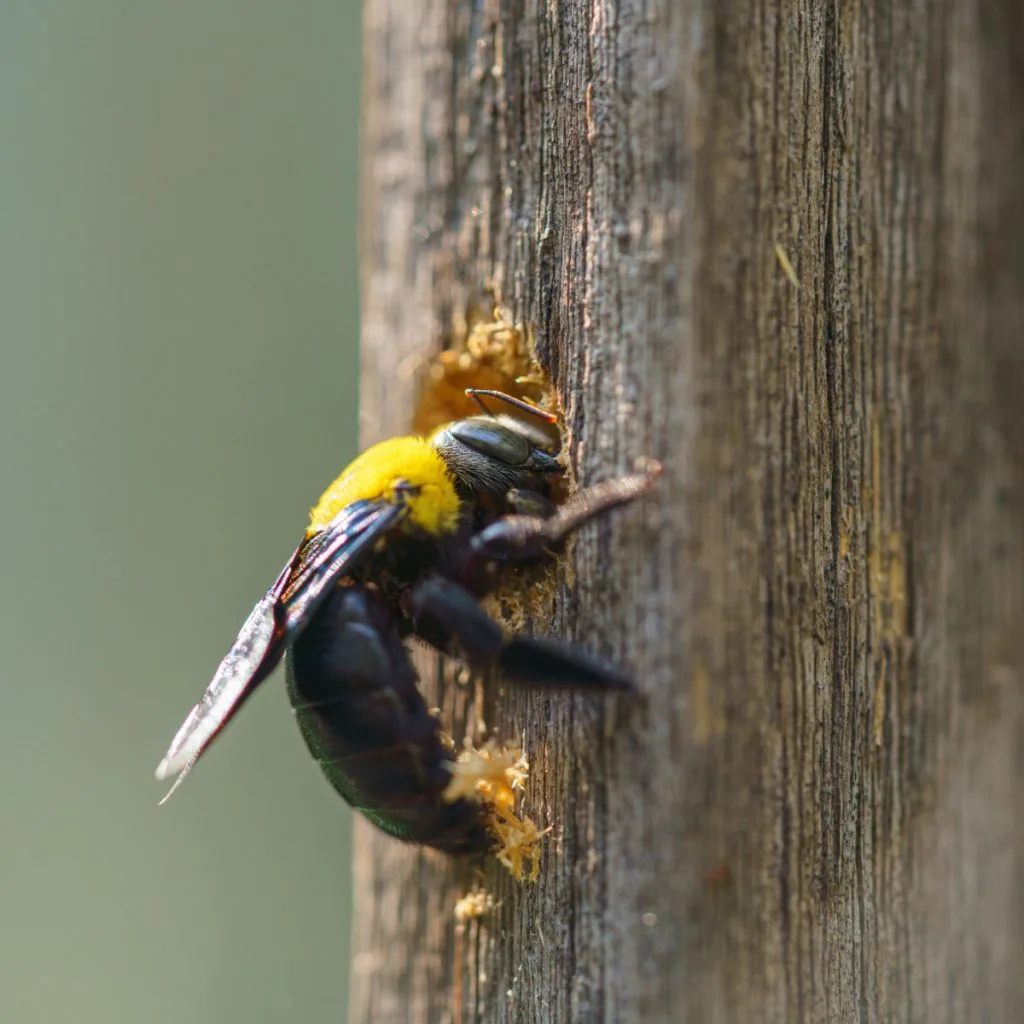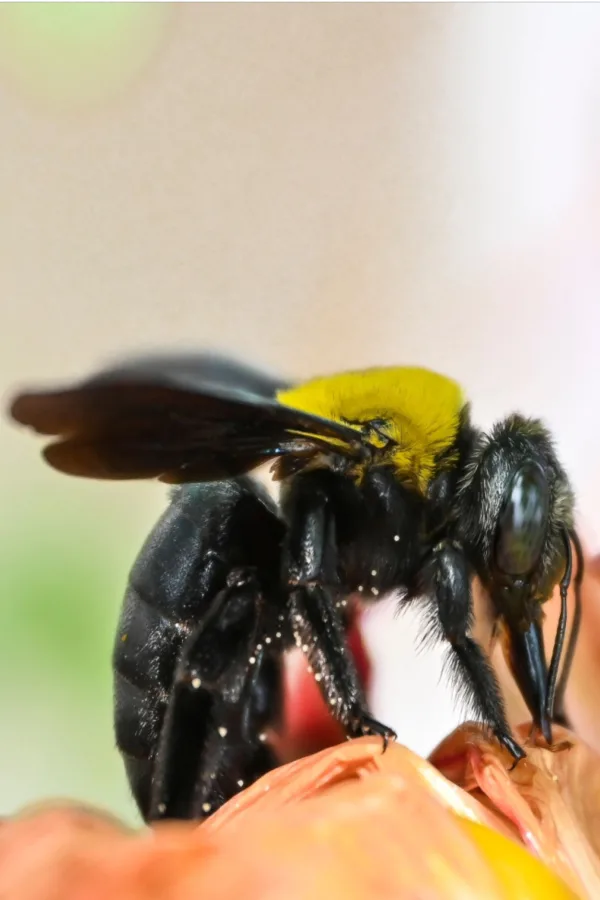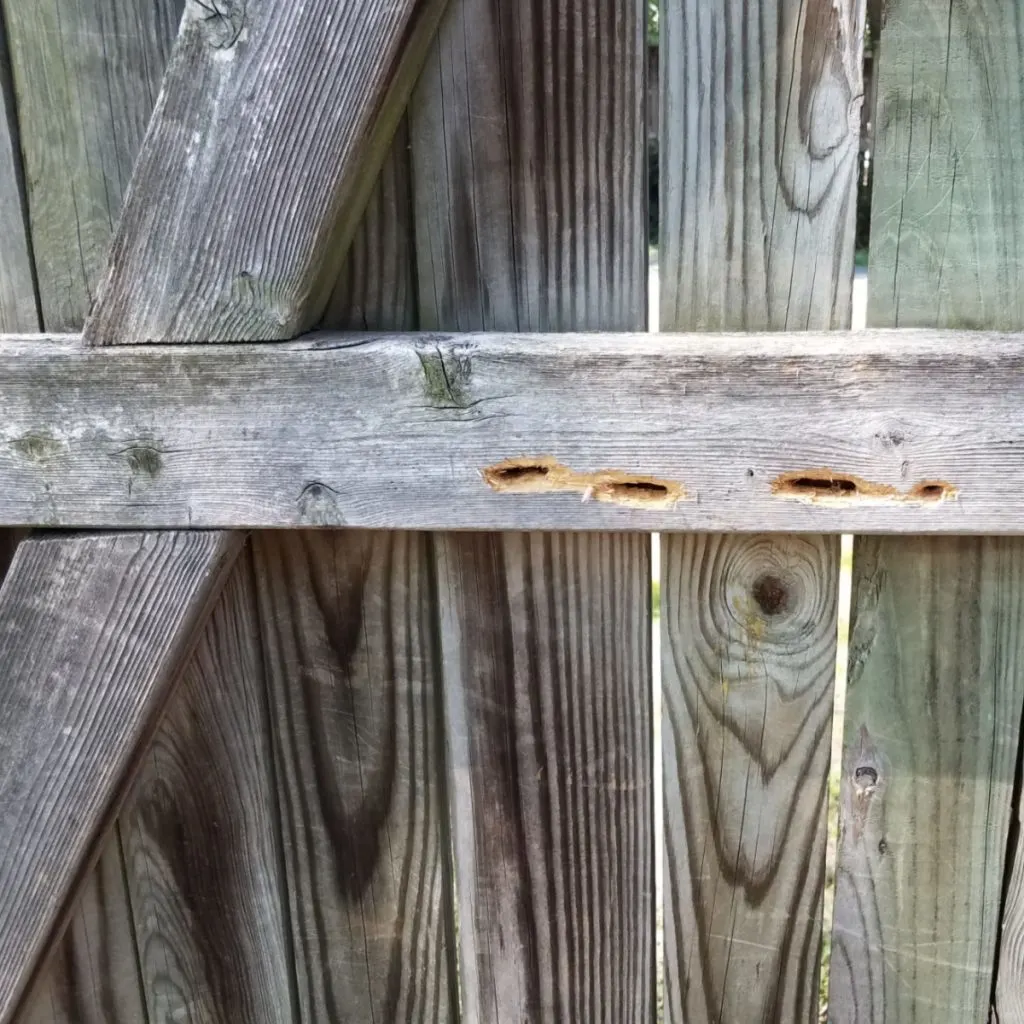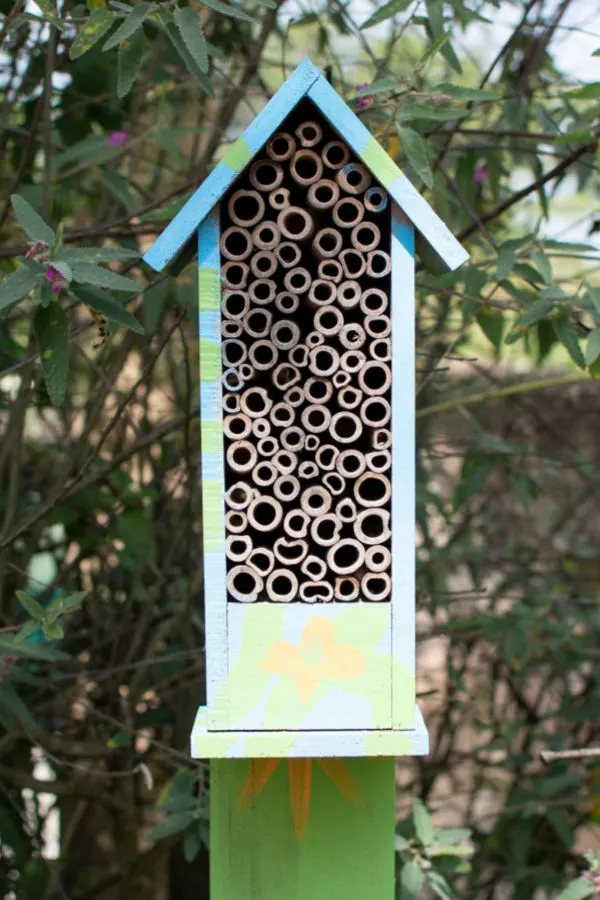Having trouble stopping carpenter bees from damaging the wood surfaces on your home, garage, barn or fences?
Spring is here, and so begins the onslaught of carpenter bees. And they can be relentless! Carpenter bees can cause extensive damage to the exterior wood surfaces all over your property. Not just to the wood siding and eaves on your house, but any wood surface that is exposed.
Unfortunately, once they find a surface to their liking, they keep coming back. In fact, with each new generation of carpenter bees, they will continue to drill more new holes, all while expanding their original homestead into an even larger nesting site with more tunnels.

Unlike other wood eating pests such as termites and carpenter ants, carpenter bees are not drilling into the wood for nutritional value. Instead, they are creating a home and nest for the next generation of their immediate family. And if allowed to succeed, your carpenter bee problem will only get worse with each passing year.
But here’s the difficult part – carpenter bees also have a good side. As it turns out, they also happen to be one of nature’s best pollinators. Especially in early spring and summer when gardeners need their help the most to pollinate flowers, vegetable plants and more. So how can you stop them without killing them? Is it even possible? The answer is YES!
Stopping Carpenter Bees Safely
There are actually some amazingly effective methods for deterring carpenter bees. And, without having to resort to spraying harsh insecticides. These not only kill this important pollinator, but many other beneficial insects around your home too.
Success all begins with knowing how carpenter bees live and work, and then putting a few simple measures in place to stop them during their most active time.

The Lifecycle Of Carpenter Bees
A carpenter bee is often mistaken as a bumble bee. They do resemble one another for sure, but they actually live quite differently. Bumble bees usually nest in the ground and in small colonies. Carpenter bees on the other hand, live in single family units – in holes they carve out in the wood.
As in most bee colonies, the female carpenter bees are the workers. They drill the holes in the wood and also raise the larvae. The male is the protector of the nest. The males are the bees that dive bomb you when you walk or get near an existing nest.
The funny thing is, the males don’t have stingers! In fact, of all bees, carpenter bees are the least likely to sting. Only the females have stingers, but they do not like to use them and will only do so if they are extremely agitated or prodded.
The holes the females create are not just a home, but also where they lay larva for the next generation. They begin to lay their larva in the early spring and summer months, right after emerging from hibernating over the winter. This is also the time when you will begin to see damage.
Carpenter bees are most active from May to late June in most climates. This is the period where they will create their homes and also raise the new generation. And where you need to be on your toes to defend the wood around your home!
Listen To Our Podcast Below On The Secrets To Stopping Carpenter Bees!
Defending Your Home & Stopping Carpenter Bees
So how can you defend your home and wood structures without killing these important pollinators. The answer lies in a simple three-prong approach.
The first is to deter them from taking a bite out of the wood you are trying to protect. The second is making sure to clear any larva from existing damage and close the holes. The third and final part of the puzzle is to offer them a safer home to live away from your wood structures.
One thing that is important to know about carpenter bees is that they will return to the same home year after year. And that means if you provide them with a good alternative, both you and the carpenter bees can live in harmony – without damage to your home!
The good news is that once you get to mid-summer, the activity will stop. In fact, the males die off by July, and the females do not typically lay more larva until the following spring.
Deterring Carpenter Bees
There are several great options for deterring carpenter bees. The biggest and most important is to always keep your wood freshly painted, stained or sealed.
Carpenter bees prefer untreated and old wood the best. By keeping the wood surfaces around your home sealed up with paint, stain or sealer, they will often look for other areas to build their homes.
Probably the most effective way of all to deter carpenter bees is by spraying the wood surfaces they attack with a scented oil they detest. Carpenter bees do not like citrus oil, peppermint oil, or almond oil. By simply creating a spray with water and a few drops of essential oil from any three, you can usually keep them from drilling. Affiliate Link: Citrus Oil Pure
Keeping the scent strong during their time of activity (May & June) is the real key to success with deterrent sprays. Be sure to reapply after rains or heavy dew. No matter what, reapply at least once a week to keep the scent strong.
5 to 10 drops of essential oil in a small spray bottle is more than enough scent to be effective. As with any spray, always test a small surface area to make sure it won’t stain the surface. You can also find oil sprays specifically designed for carpenter bees. Product Affiliate Link: Donaldson Farms Carpenter Bee Repellent Spray
Stopping Carpenter Bees With Fake Hornet Nests
Wasps and hornets are big-time predators of the larva of carpenter bees. They will invade the nests and eat the larva. Because of this, carpenter bees do not like to live and make their homes near existing wasp or hornet nests.

By simply installing a few fake nests around the areas they are attacking – they will usually move along – or not even visit and build in the first place! You can create a fake nest with a brown paper bag, or purchase some great fake nests that are ready to go. Product Affiliate Link : Fake Wasp Nests
Remove Existing Larva
Beyond deterring, if you have existing nests in your wood, you do need to clear it of any larva and fill the hole. Remember that carpenter bees will come back again and again. If the hole is there, they will once again build it out and lay more larva.
Before filling any holes, spray a solution of 50% water and 50% household vinegar into the hole. This will kill any existing larva, which you need to do before filling. Then fill the hole with wood filler to seal it off from future home building.
Giving Carpenter Bees Their Own Home
Because carpenter bees are an important pollinator, having them around is actually advantageous for gardeners. If you can give them their own “safe space” to live and breed, it will help stop them from attacking your own wood structures.
You can purchase ready to go carpenter bee (also called mason bee houses) structures. These will entice the bees to live away from the wood surfaces you are trying to protect. Place the carpenter bee house as far as possible away from attack areas to minimize the chance of them returning.

You can also hang a mason bee house where carpenter bees are currently hovering to attract them to the nest. Once they take up residence, you can simply move it to a safer area.
Here is to stopping carpenter bees and the damage they cause to your home! For more natural pest control advice, check out our articles: How To Keep Gnats Out Of Your Kitchen & Home – For Good!, and 3 Simple Ways To Keep Ticks Out Of Your Yard This Spring & Summer!
Simple Garden Life
Follow Our Facebook Page For Even More Great Tips! Simple Garden Life Facebook Page
Simple Garden Life is a website dedicated to keeping gardening fun, simple and enjoyable! We publish two new articles each week along with a new garden podcast episode every two weeks. This article may contain affiliate links.

